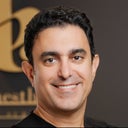How do I mitigate my Doll's Eye (orbital fat loss) condition now that Dr. Meronk retired? I really would like someone to do Meronk's technique of fat pearl graft with the fat strip overlay in my eye crease. I am 57 and the fat loss will accelerate without intervention as I age. By the way, I had fat transfer just below the brow, above the brow and below the eye 3 weeks prior to this photo. Much of it has since resorbed.
Answers (6)
From board-certified doctors and trusted medical professionals

Dr. A.J. Amadi, MD
Oculoplastic Surgeon, Board Certified in Ophthalmology
Answer

Dr. Nelson Lee Novick, MD
Dermatologic Surgeon, Board Certified in Dermatology
Answer
More Eyelid Surgery Questions
See all Eyelid Surgery Q&AWE SEND PRETTY
EMAILS
What’s trending? Who’s turning heads? Which TikTok myths need busting? We’ve got you. No fluff, no gatekeeping—just real talk. Get our free, unfiltered newsletter.